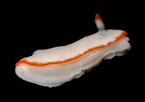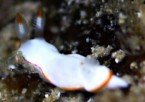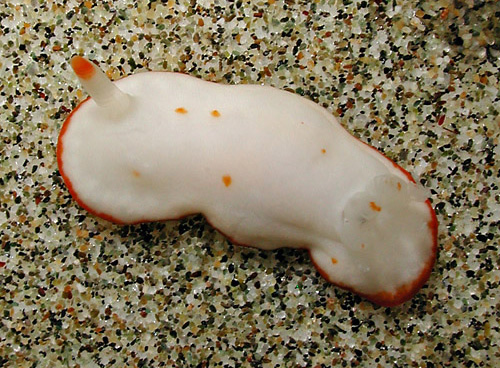| Home |
| Acknowledgments |
| Conventions |
| Glossary |
| Maps |
| References |
| Links |
| Articles |
| Thumbnails |
| Species
list |
| Family |
| Next
species |
Additional Photos

side

underside

young, about 3 mm

Verconia simplex (Pease, 1871)

| Maximum size: 18 mm (Kay,
1979). Identification: This is an oval species that often appears to bulge laterally in the center. It is opaque-white to pinkish-white with a few orange spots scattered randomly over the central area of the notum. The rhinophores and gills are tipped with orange and there is a narrow marginal line that varies from orange to violet. The orange markings on the rhinophores, notum and gills distinguish it from the similar appearing Goniobranchus verrieri. Natural history: Kay (1979) reports this species as being common under rocks in the shallow subtidal and usually found "firmly lodged in crevices." However, it has seldom been seen in recent years. The two recent specimens we are aware of were found at about 6 m (20 ft) in an exposed rocky area and in the shallow subtidal in a highly protected area. It feeds on pink sponges of the genus Darwinella (Gosliner, et. al., 2018) and lays a cream egg mass (Kay & Young, 1969). Distribution: Oahu and Kauai: widespread in the Indo-Pacific. Taxonomic notes: This is the species listed as Hypselodoris peasei (Bergh, 1880a) in Kay, 1979 as well as Kay & Young, 1969. The name means "simple." It was probably first reported from Hawaii in Kay & Young, 1969. It's listed in many sources as Noumea simplex. Photo: CP: left rhinophore missing: 2017 MarineGeo; Kaneohe Bay, Oahu; May 27, 2017. Observations and comments: Note 1: ( ) |
| Thumbnails |
Species
list |
Family | Next species | Top |